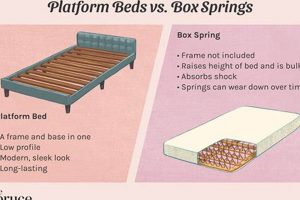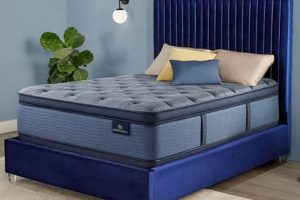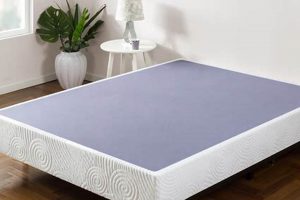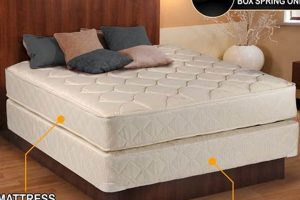A bed delivered in compact packaging, significantly smaller than a traditional mattress, has gained considerable popularity. This product is typically composed of memory foam, latex, or a hybrid of materials, compressed, rolled, and then sealed within a protective container for ease of shipping. Upon unboxing, the item expands to its intended size, ready for placement on a bed frame or foundation.
The convenience of delivery and setup are prime advantages. Eliminating the need for specialized delivery services and offering easier maneuverability through doorways and stairwells contributes to reduced shipping costs and simplified in-home installation. This streamlined process has revolutionized the way consumers purchase and receive bedding, disrupting traditional retail models and appealing to those prioritizing efficiency and value.
The subsequent sections will delve into specific characteristics, material compositions, and considerations for selecting the optimal option. Further examination will also cover factors to consider such as firmness levels, edge support, and heat retention properties, aiding in making a well-informed purchase decision.
Considerations for Acquiring Bedding in Compact Packaging
This section outlines key considerations when evaluating bedding delivered in compressed form. Careful evaluation of these factors ensures a satisfactory purchase aligned with individual requirements.
Tip 1: Evaluate Density and Material Composition: Scrutinize the type of foam, latex, or coil system utilized. Higher density foams often translate to enhanced durability and longevity, while coil systems contribute to improved support and airflow.
Tip 2: Assess Firmness Level: Firmness is subjective but crucial. Consider sleeping position and body weight. Side sleepers typically benefit from softer surfaces, while back and stomach sleepers may prefer firmer options for optimal spinal alignment.
Tip 3: Examine Edge Support: Evaluate the degree of edge support, particularly if sharing the sleeping surface. Stronger edges prevent roll-off and maximize usable surface area.
Tip 4: Research Heat Retention: Some materials retain more heat than others. Individuals prone to overheating should seek models with cooling technologies, such as gel-infused foam or breathable covers.
Tip 5: Review Trial Periods and Warranty Policies: Reputable manufacturers offer generous trial periods and comprehensive warranties. This allows for in-home testing and protection against manufacturing defects.
Tip 6: Check for Certifications: Look for certifications like CertiPUR-US. This verifies that the foam used has been tested for emissions and harmful chemicals.
Tip 7: Consider Foundation Compatibility: Ensure the chosen model is compatible with the existing bed frame or foundation. Improper support can compromise performance and void warranties.
These considerations provide a framework for making a discerning selection. Evaluating material quality, firmness, support features, and warranty policies is crucial for long-term satisfaction.
The subsequent section will address common misconceptions regarding the purchase of bedding in this format, further clarifying the decision-making process.
1. Compressed for shipping
The characteristic of being compressed for shipping is fundamental to the concept. This compression process involves compacting the mattress, typically constructed from flexible materials such as foam or latex, to a significantly smaller volume. This reduced size allows for packaging within a manageable container, facilitating standard shipping methods rather than specialized freight delivery often required for traditional mattresses. Without this compression, the feasibility of direct-to-consumer sales and ease of transport would be severely limited.
The process has dramatically altered the economics of the bedding industry. For example, prior to this development, retailers incurred significant expenses for warehouse space, specialized delivery trucks, and personnel trained to handle bulky items. The ability to ship via standard carriers drastically reduces these costs, translating into potential savings for the consumer. Furthermore, apartment dwellers and those living in areas with limited accessibility benefit from the ease with which a mattress in this form can be moved into the intended space. Real-world examples include brands like Casper and Purple, which built their business models on this convenience, directly addressing the challenges of traditional mattress delivery.
In summary, the compression aspect is not merely a convenience; it is an essential component that defines the category and enables its market viability. Overcoming the inherent challenges of transporting large, unwieldy items is the key advantage, revolutionizing distribution channels and democratizing access to a wider range of bedding options. This understanding highlights the vital role that innovative packaging plays in shaping consumer experiences and reshaping entire industries.
2. Foam, latex, or hybrid
The composition of the core materialsfoam, latex, or a hybrid thereofis an integral factor in defining the characteristics and performance of a mattress delivered in compressed form. This material selection directly influences attributes such as comfort, support, durability, and temperature regulation, impacting overall sleep quality.
- Foam Composition and Conformability
Foam, typically memory foam or polyurethane foam, offers varying degrees of contouring and pressure relief. Memory foam, for example, conforms closely to the body, distributing weight and minimizing pressure points. Higher-density foams generally exhibit increased durability and resistance to compression over time. The type and density of the foam directly correlate to the overall feel and longevity of the mattress. An example is the Tempur-Pedic brand, known for its high-density memory foam offering superior support and pressure relief.
- Latex: Natural and Durable
Latex presents an alternative with distinct properties. Derived from the sap of rubber trees, latex offers a responsive and buoyant feel. It is naturally hypoallergenic and resistant to dust mites, making it a suitable choice for individuals with allergies. Latex also exhibits excellent breathability, promoting airflow and reducing heat retention. The Dunlop process produces a denser, firmer latex, while the Talalay process yields a softer, more consistent product. A real-world application of latex can be observed in mattresses offered by brands such as Avocado, which emphasize natural and sustainable materials.
- Hybrid Designs: Combining Materials
Hybrid models integrate both foam and innerspring systems. Typically, a layer of foam (memory foam or latex) is positioned atop a coil support core. This design aims to combine the pressure-relieving properties of foam with the support and airflow benefits of innerspring coils. The coil system also contributes to improved edge support and overall structural integrity. The Saatva brand is a representative example, offering hybrid mattresses that blend the comfort of foam with the support of a coil system.
- Material Certification and Health Considerations
Certification programs like CertiPUR-US are pertinent. These programs verify that the foam used in the mattress has been tested for emissions and harmful chemicals. Awareness of these certifications is beneficial for consumers concerned about indoor air quality and potential health impacts. Many manufacturers are focusing on the use of eco-friendly and non-toxic materials. Selecting a model with relevant certifications ensures a safer and healthier sleep environment. The focus on certifications emphasizes a growing consumer concern for the health and safety of the materials used in their sleep products.
The interplay between these materials defines the overall sleeping experience. Each offers unique advantages, catering to diverse preferences and needs. Consideration of these material properties is crucial when assessing the suitability of a particular bed.
3. Convenient home delivery
The paradigm shift in the bedding industry towards compressed mattresses is intrinsically linked to the rise of convenient home delivery. This streamlined distribution model is not merely a peripheral benefit but a defining characteristic that distinguishes bedding delivered in compact packaging from its traditional counterparts. The ability to ship a fully functional mattress directly to a consumer’s doorstep eliminates the logistical complexities and costs associated with traditional retail models, where specialized delivery services and physical storefronts are essential. The compressed format enables the use of standard shipping carriers, significantly reducing transportation expenses and broadening market reach. This directly addresses a key pain point for consumers, circumventing the often cumbersome and expensive process of transporting a conventional mattress.
The impact of convenient home delivery extends beyond cost savings. It streamlines the purchasing experience, removing the need for consumers to navigate crowded showrooms or coordinate delivery schedules with specialized companies. Direct-to-consumer brands like Purple and Nectar have successfully leveraged this advantage, offering a seamless online ordering process coupled with free or low-cost shipping. The practical significance lies in the enhanced accessibility and convenience offered to consumers, particularly those in urban environments or remote locations where traditional mattress retailers may be less accessible. For instance, individuals living in apartments with narrow stairwells can easily manage a compressed mattress, eliminating the challenges associated with maneuvering bulky items through confined spaces. This ease of transport is not merely a convenience but often a necessity for many consumers.
In conclusion, the fusion of compressed bedding with convenient home delivery has reshaped the mattress industry, prioritizing accessibility and cost-effectiveness. This model addresses long-standing logistical challenges, empowers consumers with greater purchasing control, and has become a cornerstone of the modern bedding market. Understanding the symbiotic relationship between these two elements is crucial for appreciating the disruptive impact and widespread adoption of compressed mattresses.
4. Simplified Setup
The characteristic of simplified setup is an intrinsic element. This accessibility is a direct consequence of the compressed packaging and inherent design. Unlike traditional mattresses requiring specialized handling and professional installation, bedding delivered in this compact form is designed for consumer self-installation. The process typically involves unboxing, carefully removing the protective layers, and allowing the mattress to expand to its full size. This procedure eliminates the need for specialized tools or technical expertise, empowering individuals to complete the setup independently.
The practical significance of simplified setup resides in the reduced time and effort required to make the bedding operational. This attribute is particularly valuable for individuals with limited mobility, those residing in apartments or homes with narrow access points, and consumers seeking to avoid the scheduling constraints and associated costs of professional delivery and installation services. Consider the hypothetical example of an elderly individual residing in a second-floor apartment; the capacity to independently unbox and set up their bedding, without relying on external assistance, is a tangible illustration of the benefits of simplified setup. Real world examples can be shown by viewing unboxing videos, consumers have widely shared videos demonstrating that set up can be done in less than 15 minutes. Moreover, the ease of setup extends to the portability of the bedding, facilitating relocation or rearrangement within a household. This portability aspect differentiates it from conventional mattresses, which are often cumbersome to move.
In summary, the streamlined setup process is a key advantage, directly contributing to the widespread adoption and consumer satisfaction. The removal of logistical barriers, coupled with the ease of self-installation, enhances the overall purchasing experience and reinforces the appeal. This aspect significantly differentiates them from traditional counterparts, establishing the importance of this design element within the modern bedding landscape.
5. Variety of firmness
The availability of diverse firmness options is a crucial aspect that defines bedding compressed for shipping. This attribute directly addresses the subjective nature of comfort and support, acknowledging that individual preferences and physiological needs vary considerably. The inherent construction, typically involving layers of foam or latex, lends itself well to customization, allowing manufacturers to offer a spectrum of firmness levels ranging from plush to extra firm. This stands in contrast to traditional innerspring mattresses, where firmness options are often more limited by the underlying coil structure. The breadth of choices ensures a greater likelihood of finding a model that optimally aligns with a consumer’s specific requirements. A real-world instance of this customization is demonstrated by the Saatva mattress company, who offer three firmness options in their Loom & Leaf mattress: relaxed firm, firm, and extra firm.
The significance of this variety extends beyond mere personal preference. Firmness directly impacts spinal alignment, pressure point relief, and overall sleep quality. A surface that is too soft may lead to spinal misalignment and exacerbate back pain, while a surface that is too firm can create pressure points and discomfort. The optimal firmness level depends on factors such as sleeping position, body weight, and pre-existing medical conditions. Side sleepers, for example, typically benefit from a softer surface that allows the shoulders and hips to sink in, maintaining spinal alignment. Back sleepers often require a medium-firm surface for adequate support. Stomach sleepers generally need a firmer surface to prevent excessive sinking of the hips. This inherent adaptability allows for a more tailored sleeping experience. Nectar and DreamCloud are two brands that have widely different firmness level ratings, that make it easy to buy the mattress that fits their needs.
The widespread availability of diverse firmness options is not simply a marketing tactic; it is a fundamental element that contributes to consumer satisfaction and the overall success of compressed mattresses. It acknowledges the individualized nature of sleep needs and empowers consumers to make informed choices. This adaptability is a key differentiator, enhancing the appeal and solidifying its position within the modern bedding market.
6. Expands after unpacking
The characteristic of expanding after unpacking is not merely a feature, but a defining transformation that underpins the entire concept of bedding compressed for shipping. This expansion process is the direct result of compressing a mattress, typically composed of flexible materials, to a fraction of its intended size for efficient transport. The container maintains this compression. Upon release from this confinement, the internal structure rebounds, causing the mattress to expand to its designed dimensions. This capability is not incidental; without it, the convenience and cost-effectiveness that characterize this product category would be rendered impossible. A practical example is the initial hesitation many consumers exhibited when these products first emerged. The very idea of a full-size mattress fitting into a relatively small box seemed implausible, until witnessing the expansion firsthand.
The expansion is contingent upon the elastic properties of the materials employed. Memory foam, latex, and hybrid constructions are specifically chosen for their capacity to withstand compression and subsequently recover their original shape and volume. The unboxing videos often depict the immediate, almost dramatic, inflation as the mattress is released from its packaging. This visual demonstration serves as a powerful marketing tool, reassuring potential buyers that the compressed state is temporary and reversible. Furthermore, the speed and completeness of the expansion are indicators of quality. A model that expands rapidly and uniformly to its specified dimensions suggests superior material resilience and manufacturing precision. In contrast, incomplete or uneven expansion can signal inferior materials or compromised construction. Many brands emphasize this feature by adding instructions to allow the mattress time to fully expand before sleeping.
In conclusion, the “expands after unpacking” aspect is central to the viability and appeal of the compact bedding category. It is the culmination of compression technology, material science, and innovative packaging. Addressing initial skepticism, it provides a tangible demonstration of functionality and value. This expansion process, therefore, is not just a characteristic but is a fundamental element, linking directly to the core advantages of convenience, affordability, and accessibility that have driven the widespread adoption of these products.
Frequently Asked Questions About Bedding Delivered in Compact Packaging
The following questions address common inquiries and concerns regarding bedding that arrives in a compressed format.
Question 1: Will a compressed product fully expand to its advertised size?
Most models will expand to their advertised dimensions within 24 to 72 hours after unboxing. Variations in temperature and humidity can influence the expansion rate. It is advisable to consult the manufacturer’s instructions for specific guidelines.
Question 2: Is the quality of a compressed mattress comparable to that of a traditional model?
Quality is primarily determined by the materials used and the manufacturing processes employed, rather than the compression method itself. High-quality foam, latex, and coil systems can be found in both compressed and traditional mattresses. Research and comparison of specifications are advised.
Question 3: Does compression affect the longevity of the bedding?
Repeated compression and decompression cycles can potentially impact the long-term durability of certain materials. However, most models are designed to withstand a single compression for shipping purposes without significant degradation. Adherence to the manufacturer’s guidelines for care and maintenance can mitigate any potential negative effects.
Question 4: Are there any specific foundations or bed frames that are incompatible with the compressed bedding?
Most standard foundations and bed frames are compatible. However, it is prudent to verify that the chosen support structure provides adequate support across the entire surface area. Slatted foundations with wide gaps between slats may not provide sufficient support and could compromise performance.
Question 5: Is there an off-gassing odor associated with the expansion process?
A slight odor, commonly referred to as off-gassing, may be present during the initial expansion phase. This odor is typically attributed to volatile organic compounds (VOCs) released from the foam. Ensure adequate ventilation by opening windows and allowing the mattress to air out for several hours. Look for CertiPUR-US certified models to minimize VOC exposure.
Question 6: What is the typical warranty period offered on compressed bedding?
Warranty periods vary by manufacturer. Most reputable brands offer warranties ranging from 10 years to lifetime coverage. Examine the warranty terms carefully to understand the scope of coverage and any limitations.
In summary, bedding delivered in compressed form offers a convenient and cost-effective alternative to traditional models. Prudent research and attention to detail are essential to ensure a satisfactory purchase.
The following section will provide resources for finding further product information.
Conclusion
This exploration has dissected the defining attributes. The compression for shipping, the composition of foam, latex, or hybrid materials, the convenience of home delivery, simplified setup, variety of firmness, and expansion after unpacking constitute the core elements. These characteristics collectively contribute to a transformed bedding landscape.
The information provided is intended to serve as a foundation for further investigation. Independent verification and personalized assessment remain crucial steps in the selection process. The decision to acquire bedding delivered in this compressed format warrants careful consideration of individual requirements and preferences.





![Best Box Spring & Mattress Queen Set [Deals!] Organic & Natural Mattress Buyer’s Guide: Non-Toxic Sleep Solutions Best Box Spring & Mattress Queen Set [Deals!] | Organic & Natural Mattress Buyer’s Guide: Non-Toxic Sleep Solutions](https://mattressworldpa.com/wp-content/uploads/2025/07/th-3396-300x200.jpg)

![Best California King Mattress With Box Spring [Guide] Organic & Natural Mattress Buyer’s Guide: Non-Toxic Sleep Solutions Best California King Mattress With Box Spring [Guide] | Organic & Natural Mattress Buyer’s Guide: Non-Toxic Sleep Solutions](https://mattressworldpa.com/wp-content/uploads/2025/07/th-3394-300x200.jpg)